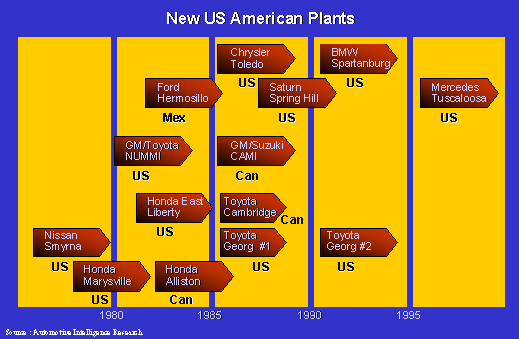

.





.
.





..

.
.
.
© 1999-2004 Copyright
Automotive Intelligence,
www.autointell.com
All Rights Reserved .
For questions please contact
editor@autointell.com
|
New American Plants
|
Starting in the
early 80s Japanese car companies came over
to the USA, in order to build their cars locally and to avoid
heavy import taxes. Nissan was first, but Honda followed soon.
Toyota applied a cooperation approach.
The American
manufacturers defined their strategy in the early 80s
as well.
General
Motors followed a twofold approach:
-
General Motors
started common projects with Japanese manufacturers, as
Nummi, which is a cooperation with Toyota
and
-
Together with Suzuki they launched Cami. These plants are well known as some
of the first transplants.
-
On the other
hand General Motors started its "Beat the Japanese"-Saturn
project, which was to focus and implement all "lean
manufacturing lessons
learned" combined with American engineering spirit to build
a car which is better than the Japanese ones.
|
|

Ford used
its cooperation with Mazda in its Autoalliance, represented
in the Flat Rock plant project. Nowadays, Ford and Mazda are - at least
to a certain extend and enforced by the newly raised share of Ford in
Mazda - discussing and defining common platforms.
Early in the 90s
the Germans arrived (back so to say, after Volkswagen
had closed its subsidiary in Westmoreland 1988).
BMW built a its first plant in the U.S. and started
producing the 3-series to train the team and than introduced the Z3,
which is explicitly build in Spartanburg.
The latest German plant
is Mercedes
in Tuscaloosa, explicitly producing the All-Activity-Vehicle M-model.
|

